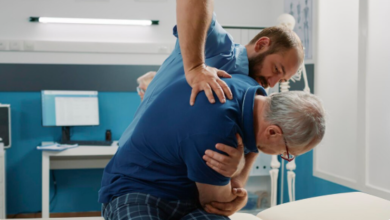Common Depression Symptoms | Signs to Recognize Early

Depression is a complicated mood disorder that impacts millions of individuals worldwide. Whether it appears as persistent unhappiness, lack of interest in activities of daily living, or debilitating fatigue, the effect of depression is profoundly disturbing to quality of life. For those seeking understanding and guidance, a most elemental question comes to mind: Common Depression Symptoms
To respond to this simply and helpfully, we are going to take you through the kinds of depression treatment, how they work together, what you can expect at each step, and how to find a provider (or center) you can trust. If you want a specialty treatment center, one place it’s worth looking is.
Why Defining “What Is Depression Treatment” Matters?
Prior to delving into specifics, understanding the complete meaning behind the question What Is Depression Treatment assists with:
- Clearness for patients — Most individuals don’t understand where to start. Clarifying the complete range of treatment minimizes confusion and reluctance.
- Establishing realistic expectations — Depression is hardly ever “cured overnight.” Comprehending the stages, obstacles, and timeline from the beginning encourages persistence and patience.
- Guidance in choosing providers — Once you understand the treatment modalities, you can more intelligently assess programs, therapists, and centers providing what you require.
- Promoting wholistic care — Treatment isn’t just pills or therapy. Optimal care frequently employs a combination of many modalities—psychological, biological, behavioral, social, and lifestyle strategies.
Core Pillars of Depression Treatment
In the vast majority of evidence-based systems, effective depression therapy is based on several interdependent columns. Any one method is not always enough; rather, a multi-component blend specific to the client usually proves most effective.
1. Assessment & Diagnosis
A thorough assessment must occur before a proper treatment plan can be constructed. This may involve psychiatric evaluation, medical screening (lab tests, thyroid function tests, vitamin levels), and rule-outs for medical explanations of mood shifts.
When assessing, clinicians identify the severity and form of depression (e.g. major depressive disorder, persistent depressive disorder, seasonal affective disorder, perinatal depression) and recognize co-occurring disorders (e.g. anxiety, substance use, or chronic medical illness).
2. Psychotherapy (Talk Therapy)
Psychotherapy is one of the core treatments in the treatment of depression. Among the most tried and true modalities are:
- Cognitive Behavioral Therapy (CBT): Aids in the recognition of negative thinking patterns and the education of skills to reframe and substitute these thoughts with healthier equivalents.
- Interpersonal Therapy (IPT): Aids in enhancing interpersonal relationships, communication styles, and overcoming bereavement or role change.
- Dialectical Behavior Therapy (DBT): Initially formulated for borderline personality disorder, DBT is occasionally modified to depression, particularly if emotional regulation proves difficult.
- Acceptance & Commitment Therapy (ACT): Assists patients in accepting challenging feelings while committing to behavior aligned with personal values.
- Psychodynamic Therapy: Investigates unresolved or unconscious conflicts and their impact on mood.
Individual, group, or family level therapy, as the context and need dictate.
3. Medication (Pharmacotherapy)
Medications to treat depression include antidepressant medications, which can provide a biological balance, particularly in moderate to severe depression. These usually fall into common categories as follows:
- SSRIs & SNRIs (e.g. sertraline, fluoxetine, venlafaxine)
- Atypical antidepressants (e.g. bupropion, mirtazapine)
- Tricyclics or MAOIs, although less frequently first-line due to side effect profile
- Augmentation techniques (adding a mood stabilizer, antipsychotic, or other adjunct) when response to a single antidepressant is incomplete
Medication management and monitoring are essential — dosage alteration, side effects, compliance, and drug interactions must be monitored closely.
See also: Personalized Treatments for Teens LA: A Holistic, Teen-Centered Approach to Mental Health
4. Lifestyle & Behavioral Interventions
Medication and psychotherapy can be supplemented by lifestyle supports:
- Exercise & physical activity — Numerous studies demonstrate consistent aerobic or resistance exercise improves mood and resilience.
- Nutrition & gut health — Adequate diets with omega-3s, whole foods, and restricted processed sugar hold promise in mood support.
- Sleep hygiene — Getting consistent, restful sleep is critical since bad sleep aggravates mood and weakens the response to therapy.
- Stress management & mindfulness — Meditation, breathing, progressive muscle relaxation, and mindfulness are techniques that assist in controlling stress hormones.
- Social connections & support — Depression is worsened by isolation. Facilitating supportive social relationships, peer support groups, or formal support aids recovery.
5. Specialized & Intensive Treatments
For individuals whose depression is resistant to treatment, extremely severe, or complicated by suicidal ideation, further approaches may be considered:
- Electroconvulsive Therapy (ECT): Frequently applied in severe, treatment-resistant depression, ECT can provide quick symptom relief under close medical monitoring.
- Transcranial Magnetic Stimulation (TMS): A noninvasive form of brain stimulation applied when medication/therapy is not enough.
- Ketamine / Esketamine therapy: In special cases, ketamine infusions or nasal esketamine (FDA-approved in certain instances) provide rapid relief for resistant depression.
- Intensive inpatient/residential or outpatient programs: In an organized environment, patients have a series of daily therapeutic sessions, supervision, group counseling, crisis intervention, and multidisciplinary care.
Lonestar Mental Health provides structured and residential programs based on severity and personal needs.
6. Aftercare & Ongoing Support
Depression tends to relapse and is therefore:
- Maintenance therapy (psychological or medication) can go on for months to years.
- Relapse prevention planning is critical: triggers, early warning signs, coping strategies, and crisis contacts.
- Peer support and community groups help with long-term recovery and alleviate isolation.
- Periodic check-ins and reassessments facilitate revising the plan as necessary.
How the Pieces Work Together?
When somebody asks What Is Depression Treatment, the most useful response isn’t a lone bullet point—but rather, how these pillars work together:
- Diagnosis & customization: An experienced clinician reviews the individual’s distinctive presentation and constructs a customized strategy.
- Parallel strategy: Psychotherapy and medication frequently go hand in hand, not one or the other.
- Layered intensity: For mild depression, therapy and lifestyle changes might be all that is needed. For moderate-to-severe, or refractory, depression, augmentation with intensive treatments, or residential programs, is employed.
- Integration: Optimal results occur when all aspects (therapy, meds, lifestyle, support) are integrated—not compartmentalized.
- Adjustment over time: Monitoring progress, side effects, and relapse risk continually shapes the strategy.
- Empowerment and self-management: Treatment gradually aims to give the person tools to maintain well-being independently.
Real-World Example: Depression Treatment in Texas via Lonestar Mental Health
If you’re considering a formal center or program, Lonestar Mental Health’s depression treatment in Texas provides a good illustration of how modern, integrated care can look. Their offerings include:
- Residential care — 24/7 monitoring, individualized treatment, and safety support
- Integration of psychotherapy (individual, group, family) with evidence-based modalities — CBT, DBT, ACT, and more
- Holistic supports (stress reduction, mindfulness, wellness) and clinical care
- Aftercare and relapse prevention planning as continuity of care
Selecting a Quality Depression Treatment Agency
As you compare options, remember these checkpoints:
- Does the provider or facility provide more than a single modality (therapy + medication + lifestyle support), not merely one?
- Are licensed professionals and psychiatrists engaged?
- Is there room for flexibility in matching intensity (outpatient, inpatient, residential) based on severity?
- Are aftercare and relapse prevention plans built into the program?
- How is continuity of care managed (i.e., handoff post-discharge, community linkages)?
- What is their track record, reviews, and outcomes?
- Are insurance or financial assistance options available?
Expectations & Common Misconceptions
- “One session cures me” — Unlikely. Progress is gradual and often non-linear.
- “You’ll take meds forever” — Not always. Some people can taper after remission with careful monitoring.
- “Therapy alone is enough” — For mild cases, sometimes yes; but moderate or severe depression usually needs a combination.
- “If one antidepressant fails, no hope” — Many patients respond once adjustments or augmentations are tried.
- “You’ll never relapse” — Depression often recurs; awareness and maintenance are essential.
Take the First Step: What to Do Now?
- Reach out to a mental health professional (psychiatrist, therapist) for a thorough evaluation.
- Ask directly: “What modalities of depression treatment do you employ?” and “Do you provide more intense care if necessary?”
- Verify credentials, reviews, and philosophy of treatment.
- If you require residential or structured treatment, consider places such as Lonestar Mental Health’s depression treatment in Texas as possible alternatives.
- Establish your support — family, friends, community, peer groups — from the outset.
Conclusion!!
The answer to the question Common Depression Symptoms cannot be a one-size-fits-all approach. Rather, it is an across-the-board, adaptable, and individualized system of treatment that combines assessment, psychotherapy, medication, behavioral therapy, specialized treatments, and extended aftercare. By recognizing these mainstay components and the ways in which they interact, you have insight and mastery over your journey toward wellness.







